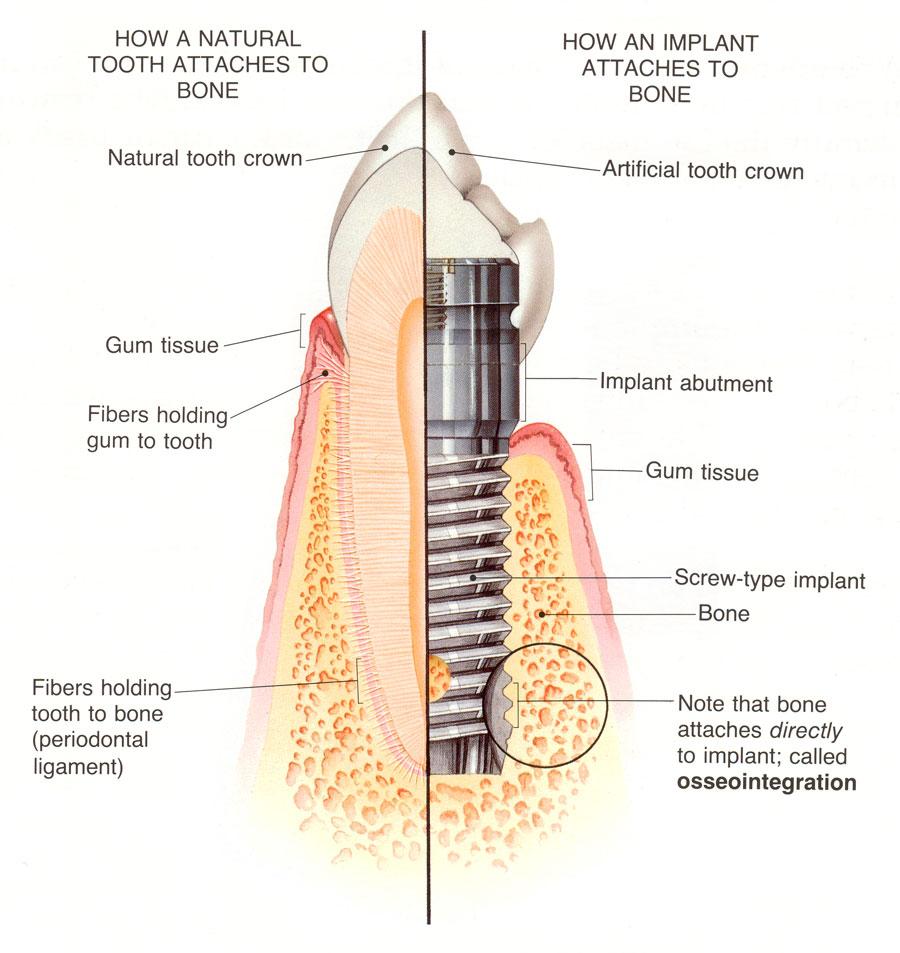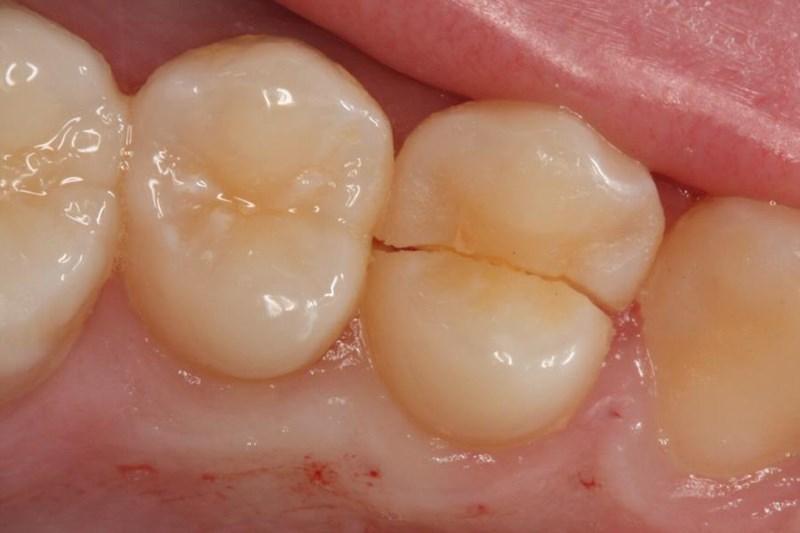Dental Implants are not just “replacement” for natural teeth. It is believed that dental implant is an “investment”!
Patients are often in a dilemma about the maintenance of their implants. Do they brush and floss their implants like natural teeth? Does food get underneath the Implant Bridge or prosthesis?
Patients look to their dentist for these concerns. We at Dr.Sachdeva’s Dental Clinic address these concerns and help our patients with an individualized home-care routine!
Difference between Dental Implant and Natural Teeth
Dental Implants replace the root part of the teeth. In between the Implant and the crown of a tooth there is often a connector known as an Abutment.
The success of the whole system is based on the implant's attachment to bone. Titanium, the metal of which implants are made, is uniquely osteophilic — literally “bone-loving.” It fuses to bone in a process called osseointegration (“osseo” – bone; “integration” – fusion or joining).
Above the bone where the integration process ends, the abutment comes in contact with the gum tissue where it is supported by a connective (i.e. “connecting”) tissue composed of fibers made of a tough material called collagen. The fibers run beneath the surface parallel to the implant ending at the top of the bone. They hold the gum tissues against the implant surface.
At the very top of the implant assembly, the abutment and lower part of the crown attach to the gum via a specialized structure known as an epithelial attachment. The cells actually attach to the highly polished metal or ceramic, of which the implants are made, by means of microscopic suction pads.
By contrast, a Tooth root is attached to the bony socket that surrounds it — by a Periodontal Ligament . The ligament is composed of tiny fibers that insert into the bone on one side and into the tooth root on the other. Above the bone, the fibers attach from the tooth into the gum tissue.
An Implant has no such attachment. Since the whole periodontal ligament has a greater blood vessel supply through which it can bring cells and nutrients, it is more readily able to resist and fight against infection.

Infection Is the Enemy
Cleaning Implant-supported tooth replacements is just as important as cleaning natural teeth, as both depend on healthy surrounding tissues for support. Bacterial biofilm (plaque) collects on implant crowns just as it does on natural teeth, and must be removed on a daily basis at home. Without daily biofilm removal, infection can develop known as Peri-Implantitis .Which can result in loss of the attachment tissues. Unlike inflammation around teeth, this reaction can be quite catastrophic both in rate and amount, quickly leading to loss of bone around an affected implant. Bone loss can rapidly progress to loss of the implant.
.jpg)
Implant Home-Care Guidelines
- Brush twice daily with a low abrasive dentifrice.
- Floss with dental tape in shoe shine motion.
- If recommended, use interdental brush, rubber tip, soft picks
- Water irrigation systems once or twice daily
- If inflammation present, use of non-alcohol anti-microbial rinse.
Removable Prosthesis Guidelines
- Remove the prosthesis (over denture)daily to soak in the specific cleaner for recommended time
- Remove the prosthesis from the cleaner and brush the underside with denture brush, being careful with the attachments.
- Rinse off the prosthesis thoroughly with water and/or non-alcohol antimicrobial rinse
- Rinse mouth with antimicrobial for 30-60 seconds and then reinsert over-denture.
- The Dentists in North Delhi, have an important role to play in keeping dental implants infection-free, and there are many factors to be considered in selecting the right instruments for a professional cleaning.
- They include: the nature of the debris, meaning whether soft (foods) or hard (calculus or tartar, calcified material); the location of the deposits; the type of surface on which they accumulate; and the stubbornness with which they adhere.
The Right Tools For The Job
At Dr.Sachdeva’s Dental Clinic in Ashok Vihar, we select instruments for cleaning that do not damage the crown, abutment, or the implant itself.
Maintaining the highly polished, smooth surface of the abutment and crown are critical. If they are scratched they can attract and harbor bacteria. That's why the instruments used, called scalers and curettes, are most often made of plastics and resins.
Natural teeth don't scratch in the same way, and therefore metal instruments can be used to clean them.
A number of power (ultrasonic) instruments have nylon or plastic sheaths or tips to minimize implant damage. They clean by using high-frequency vibration, which may be necessary if large quantities of debris have accumulated.
They are used on a low power setting with a lot of water irrigation, and sometimes antibacterial solutions, to clean and flush material.
Home care recommendations for implant care
Toothbrushes: There is no significant difference between electric or manual brushes when it comes to implant care. The main focus needs to be on adaptation to the prosthesis and patient’s dexterity.
Patient is instructed to brush twice using a soft tooth brush with a low abrasive dentifrice.
Nylon coated interdental brushes /proxabrushes are also an excellent alternative to clean the tight and hard –to-reach areas. Nylon only interdental brushes prevent scratching the implant or prosthesis.

Dentifrice and mouthwash: A low abrasive/non abrasive formula to the exposed implant is recommended. It should also contain antimicrobial ingredients.
Floss: There are many types of floss in the market, and generally it is highly recommended to use unwaxed floss or implant specific floss. Be sure to select a type that doesn’t shred or leave particles behind, as it may contribute to implantitis.
.jpg)
Oral irrigators/water flosser: It is highly recommended for patients to use oral irrigators for the reduction of plaque/biofilm, inflammation, and hard to reach areas around the implant.
Patient is instructed to use a nonmetal tip one to two times daily, and, if inflammation is present, add a diluted non-alcohol antimicrobial rinse (chlorhexidine gluconate)
Water irrigation in conjunction with diluted non-antimicrobial rinse has proven to be extremely helpful for full-fixed and removable prostheses to remove daily biofilm and prevent inflammation if used on a daily basis.
.jpg)
Protective appliances: Occlusal guards, if recommended, will decrease the occlusal load on the implant during night time grinding or clenching.
Not recommended: Plastic or metal “picks” seen over-the-counter that mimic professional instruments should be avoided. Metal instrument can scratch the implant surface, creating areas for bacteria to colonize.
What Happens When Implants are not Taken care of?
Implants can develop problems without consistent daily care. The earliest sign of a problem begins with the observation of bleeding. This is known as mucositis.
The current scientific evidence suggests that this may be successfully treated and is reversible if caught early. Unfortunately if it progresses to bone loss, also known as peri-implantitis, the bone loss is not reversible. If peri-implantitis is not treated it can lead to advanced bone loss and the removal of the implant.
Conclusion
Despite these cleaning challenges, implants are highly successful. However, the prevention of peri implant disease is fundamental to implant health, maintenance and function. And cleaning implants and their relate components is an important part of success





